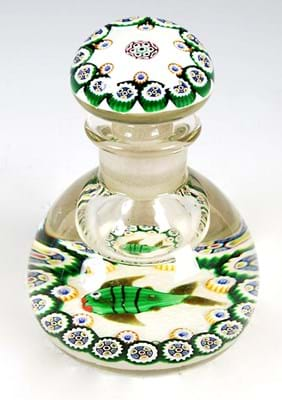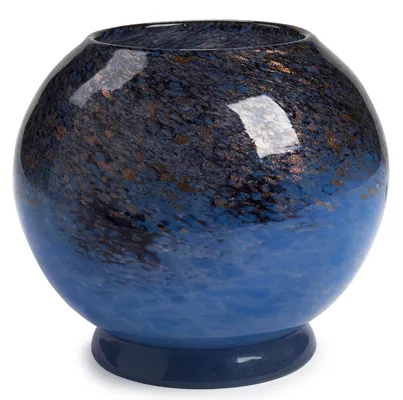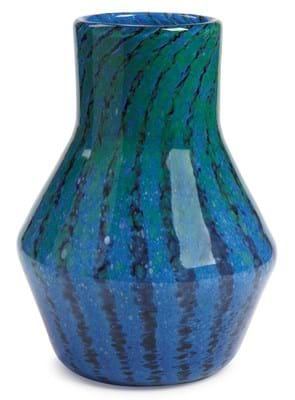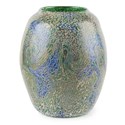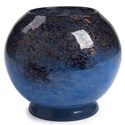The product of an unlikely collaboration between the Spaniard Salvador Ysart and Isobel Moncrieff at an industrial glassworks in Perth, this distinctive cased glass was manufactured by family members in two distinct phases from about 1922 until c.1961: first under the name Monart at Moncrieff's and from 1946 at the Shore Works as Ysart Brothers Glass.
Salvador's oldest son, Paul, developed an interest in paperweights and became a key figure in the Scottish paperweight industry.
What Do People Collect?
Two catalogues of Monart glass were produced by Moncrieff's (one under the name Monart Ware and the second with 11 pages under the Monart Glass label). Together they comprise a range of handmade decorative wares from flower holders and fruit bowls (the most common Monart objects) to table lamps and ceiling light bowls.
The major difference between the pre-War Monart glass and that of the post-War Yasart era is in the range of production colours and a wider range of shapes. Typically, Yasart reflected the more muted tastes of the 1940s and 50s with softer pastel shades.
Colour, pattern and shape play a key role in pricing. The typical production piece was fashioned by rolling or 'marvering' coloured glass powder or granules into clear or coloured blanks. Others were enlivened by adding gold powder, or aventurine, into the mix - an ingredient supplied by the Gilbert Martin factory in Paris. The mica flakes introduced c.1935 to create silver decoration came from the local Woolworth's.
Bubble inclusions were achieved by sprinkling crushed charcoal into the mix that would vaporise as the final layer of cased glass was added. Failures were frequent - it is a common complaint of Monart in general that the glass is not of the highest quality - so this decoration commands a premium.
Surface-decorated pieces are also highly desirable. Few pieces of Monart can be so accurately dated, but these early issues from a studio which began serious production in 1924 are often iridescent, an effect achieved, it seems, by impurities in the gas supply to the furnaces at the North British Gasworks. A desirable series of wares with Paisley pattern decoration also date from this early period. That the gas supply was 'improved' in 1927 (and the effects not replicated in glass production until the 1950s) gives a fairly tight three-year run for these wares.
The paperweights of Paul Ysart hark back to the wares of the 19th century French paperweight makers, excelling in the traditional techniques of millefiori, latticino and lampwork.
Identification
The most daunting problem for any new collector of Monart and Ysart glass is identification. It is often confused with glass by Whitefriars, Gray-Stan (Battersea) and Nazeing Glass (Hertfordshire), while similar wares were made in Bohemia, Stourbridge, Czechoslovakia and by the American Union Glass Company.
The letters and numbers which collectors use when describing Monart can seem a little baffling to the novice, but they simply refer to the code used by the Ysarts in two pattern books (reproduced online at www.ysartglass.com). Sizes were given Roman numerals from I+, the largest, to XII, the smallest.
The shape codes were alphabetical, starting at A and finishing with ZK. The last code stands for a colour combination and decorative technique numbered from 1 to 500. Unlike post-War Ysart that typically carries an acid-etched signature, very few pieces of Monart glass were ever signed, but paper labels were attached to most pieces and, when they survive, contain these codes for the size, shape, colour mix and decoration.
The match holder pictured here retained a retailer's label for Watsons China Hall, High Street, Perth, and a manufacturer's paper label X+QJ.428. This translates as a cylindrical vessel with an integral dished base (QJ), standing 2.75in (7cm) high (X+), made in mottled green with aventurine inclusions to the rim (428).
Anyway, it's a scarce form and it sold on its own a little above estimate at £340 at Lyon & Turnbull of Edinburgh in 2006.
The Market
Despite all its importance in the history of British glass, Monart - the studio that transported the Nancy art glass movement to Perthshire - remains in its relative collecting infancy.
As a recognised collecting brand, Monart (and to a lesser extent its post-War incarnation Ysart) first came to notice in the 1980s.
At one- and two-figure price levels, it attracted its first specialist dealers (Frank Andrews and Nigel Benson) and its first prolific collectors (Michael Parkington and Ian Turner). It was Turner who wrote one of the first articles on Monart for the British Glass Between The Warsexhibition at Broadfield House Glass Museum in 1987 and co-wrote Ysart Glass published in 1990, the event that brought Monart to the wider attention of the collecting fraternity and triggered significant price increases.
If in the early 1990s it was still possible to purchase good pieces in the £150-300 bracket, that would change in 1997 and 1998 when Parkington's finely-tuned collection was sold in two parts at Christie's South Kensington.
At the time, there was some suggestion that the market might be flooded by close to 500 pieces of Monart and Ysart, offered in 246 lots. Instead it was something of a market maker, establishing the price levels that still govern today.
While small pieces can still be bought for under £50 (Yasart period glass tends to be significantly cheaper) rarities can bring four figure sums when in perfect condition.
Ian Turner, who owned more than 260 pieces of Monart sold his collection at Christie's South Kensington in September 2003. By April 2004, Lyon & Turnbull had established the auction record for Monart: £4000 bid for an apparently unique lamp fashioned in mottled orange glass, overlaid with green and brown glass and acid etched with a frieze of trees. The many losses that were incurred in the production process dictated that only a handful of pieces of the Monart 'cameo' range are known.
Further Reading
Ysart Glass by Ian Turner, Alison Clarke, Frank Andrews. Volo Edition 1990. ISBN-13: 978-0951446515


